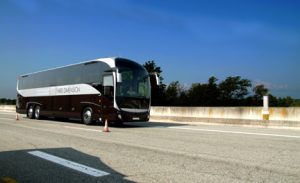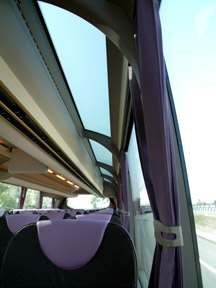By Doug Jack
Keeping you up to date with developments in Europe has never caused me hardship, but some assignments really are fantastic. This letter is from Stresa on the banks of Lake Maggiore in northern Italy, where I visited the Fiat/Iveco test track at Balocco and Irisbus, a division of Iveco and the second largest bus and coach manufacturer in Europe.
Irisbus formed from the separate French bus and coach building operations of Iveco and Renault and has since nearly totally renewed the extensive product range for city, suburban, interurban and coach applications, all with a high degree of mechanical commonality.
Irisbus has five main manufacturing plants across Europe. A large factory in Annonay, south of Lyon in central France, builds city buses and luxury coaches. Another factory in central west France builds the Heuliez city bus range. A factory in Barcelona, Spain, makes chassis. Valle Ufita inland from Naples builds buses and coaches mostly for the Italian market.
The Magelys features a distinctive soft, rounded, friendly styling popularly known as the blob. Irisbus builds its Magelys HDH in the factory in Annonay, France, not far from the headquarters in Lyon.
Two years ago Irisbus launched the Magelys HD, a two-axle coach built to an overall length of 40-ft, a height of 11-ft, 10-in, and the European standard maximum width of 8-ft, 4-in.
But the industry always looked for the company to introduce longer, higher versions that would compete at the very top luxury segment in the European market.
My trip to the plant was for the launch of the new Magelys HDH. My visit included a tour of the test area to appreciate the ride and handling of the new bus, and then out onto the high speed circuit to examine a selection of buses and coaches lined up for test driving.
I always feel a buzz entering the proving grounds of a major manufacturer. Alfa Romeo developed the original Balocco circuits that now include a more extensive selection of test tracks. High-speed circuits for cars and commercial vehicles, undulating country roads with adverse cambers and roads with very rough surfaces reveal any potential weaknesses far faster than normal roads. At the heart of the complex, Irisbus refurbished a typical old farmhouse building to use as a conference and hospitality center.
Irisbus built the Magelys HDH to an overall length of 45-ft, 3-in and a height of 12-ft, 6-in, which the clever and lightly curved styling deceptively conceals.
The latest generation of small bi-xenon lighting gives excellent visibility in night driving conditions, as does the full-width glass screen above the main windshield. For passengers sitting further back in the vehicle a novel 23-in LCD screen and smaller drop-down 19-in screen can show the route ahead.
The Magelys vehicles have additional slim glazing panels on each side of the roof, just above the main roof rails. These panels let more light into the vehicle and enable passengers to see higher up when traveling through a city or touring in a mountainous region.
The new HDH full-length center glazed and tinted roof panel ensures a well-insulated interior. Even with only 10 to 12 people on board the difference in temperature between the front and the rear was only one degree.
Iveco has a very good reputation for engine development. The HDH uses one from the Cursor family of modern engines that produce high power and torque for their lower cubic capacity. Just over 630cu the Cursor 10 delivers a maximum of 450bhp and a peak torque of 2,100nm. While some European manufacturers now think an eight-speed automated gearbox is sufficient for a coach, the latest smooth and intelligent AS-Tronic can skip gears if accelerating on the level.
The controls for the ZF AS-Tronic fully automated manual transmission are on the steering wheel.
Independent front suspension is standard on both the first and third axles and they give an industry-leading turning circle — a major advantage in old European towns and cities. Out on the test track, the Electronic Stability Program kept the coach remarkably stable, despite the forces generated in each maneuver.
The fit and finish of the interior trim is to a very high standard. Only Irisbus and Setra make their own coach seats in Europe. The seats on the Magelys come fitted with lap belts and foot rests. Service functions such as reading lights and hostess call buttons are located in the back of the seat in front, making it much easier to re-space seats if an extended tour does not require the full number.
A number of safety systems on the Magelys HDH are standard, with other equipment optional such as a lane departure warning system. A radar sensor in the front panel constantly monitors the white lines that separate the lanes on a multi-lane highway. If the driver signals to other traffic that he is changing from one lane to another, LDWS stays silent. If he drifts from one lane to another without signaling the system senses he might not be fully attentive and warns him by gently vibrating the edges of his seat until he comes back into line without alarming the passengers.
Doug Jack is with Transport Resources in the United Kingdom.



